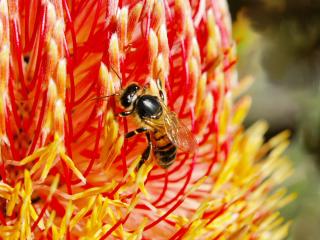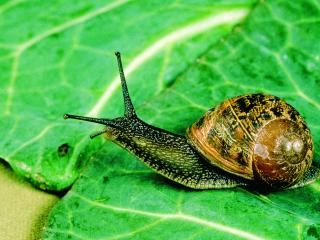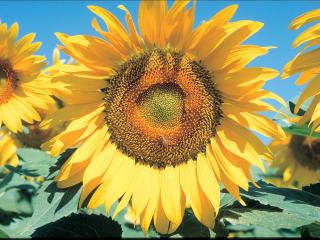About natural alternatives
The term 'natural alternatives' covers a range of options. Commercial organic growers consider any naturally occurring mineral or botanical compound acceptable — for example, copper spray to combat fungal or bacterial disease and pyrethrum to kill insects.
Stainless steel mesh may not be a 'natural' material, but it is certainly a non-chemical way of stopping termites entering any timber structure in the home or garden. Another physical barrier that serves the same purpose is crushed granite.
A number of commercially available insecticides are biological. Diatomaceous earth (fossilised remains of diatoms, a type of hard-shelled algae) kills aphids, ants and caterpillars by desiccating them.
Some products contain soil bacteria such as actinomycete or Baccilus thuringiensis that are toxic to certain beetles and caterpillars. Other products have spinosad as the active ingredient; derived from a soil fungus, this is toxic to several different insect species and is used in the commercially available splash bait used in the control of Mediterranean fruit fly.
Biological insecticides should be handled and used just as carefully as chemical products — and always read the label.
Safety first
When using any pesticide take the following precautions:
- Wear disposable plastic gloves.
- Consider whether eye protection is needed.
- Wash containers and utensils thoroughly after use or, preferably, label an old set and only use these for sprays.
- Store liquids in glass jars, clearly labelled and out of children’s reach.
Practical considerations
Many alternative pesticides work through direct contact so you need patience and care to achieve good surface coverage. Fungicides need to be applied at the first trace of mildew or rust.
Test on lower leaves first, to see if adverse effects such as burning of foliage occur. Some alternative pesticides may only have a short shelf-life. Sprays should not be used if hot (above 28°C) dry weather is forecast, since this increases the chance of burning.
Natural remedies
Many natural remedies have not been scientifically tested or evaluated conclusively. Their popularity suggests they work but the degree of success is unknown, so it is best to treat them as tools to reduce pests and diseases rather than to eradicate them completely.
The following popular natural pesticides are commercially available.
Garlic spray for aphid infestation
Products, which are commercially available contain either pure garlic concentrate, or additional ingredients such as piperonyl butoxide and pyrethrins. Consult your local nursery or chemical retailer for more details.
Use a wetting agent to help the liquid to adhere to the plant. The garlic acts as a general deterrent and the additional use of white oil may suffocate the aphids.
Chilli spray for soft-bodied insects
Some products available contain chilli as well as garlic and pyrethrins. These products claim to kill, deter and irritate insects. Spray on aphids, ants and caterpillars.
Take care when using this product as chilli is a serious irritant to the skin and especially to the eyes. After peeling off your gloves, wash your hands well.
Bordeaux spray for fungal diseases
Bordeaux spray is a mixture of copper sulphate and lime. This is effective on leaf curl and brown rot on stone-fruit trees. There are a number of products commercially available for the home gardener.
Follow label instruction during application as this mixture may irritate eyes and skin. As it will burn the foliage of plants, only apply chemical in autumn at leaf-drop and again in late winter while trees are still bare.
Molasses spray for chewing insects
Caterpillars and other chewing insects apparently dislike the taste of leaves treated with this spray. Dissolve one tablespoon of molasses in one litre of warm water and add a teaspoon of liquid soap. Spray both upper and lower surfaces of the leaves.
Some gardeners claim that by doubling the amount of molasses and applying the solution to the soil, they have achieved a degree of success against root knot nematodes.
Oil sprays for sap-sucking insects
These work by suffocating mites, scales and other soft-bodied sap-suckers. A number of companies sell petroleum oil under the name ‘white oil’ or ‘horticultural oil’ for home gardeners. White oil controls leaf miner, scales, aphids, mealy bugs and mites. Botanical oils, made from plant oils, are also available and work in the same way.
Kitchen remedies for pest control
Anecdotally the following remedies are useful for pest control.
Lethal drinks for slugs and snails
Lay a jar on its side, partially buried so the lip is flush with the soil. Pour in beer, wine or a yeast beverage as these attract the slugs and snails which drown in the liquid. For optimum results place the jars in cool damp spots.
An alternative is to spray seedlings and surrounding soil with one part strong espresso coffee to 10 parts water. The theory is that slugs and snails crossing the soil absorb caffeine and die. This solution should be re-applied after rain.
Milk spray for powdery mildew
This is effective provided you get good coverage of the foliage or fruit. Applications should be no more than 10 to 14 days apart, depending on the weather.
Mix one litre of water with 100ml of milk (or 200ml if the disease is well established). Fresh or powdered milk can be used. Full cream milk is slightly more effective than skim milk. Applications work best if applied as soon as the disease is noticed. Milk is unlikely to eradicate the disease once it is established.
Bicarbonate sprays for fungal diseases
These are used on powdery mildew and black spot. The bicarbonate may be sodium bicarbonate, commonly called bicarb of soda, available from grocery stores or potassium bicarbonate which can be bought from some hardware stores.
Mix 10g (about two teaspoons) into one litre of water and add 2-4ml of horticultural oil. Again, full coverage and regular applications are critical.
Some recipes substitute vegetable oil for horticultural oil but, bicarbonate sprays in particular are likely to burn leaves if used on hot days.
Prevention is better than cure
Chemicals are the last resort, and home-made natural alternatives should be the second last resort because they, too, may upset the ecosystem.
Minimise the risk of introducing pests and diseases to your garden in the first place by buying plants, soil, potting mix and mulch from reputable sources.
Practice good hygiene by, for example, cleaning pruning tools before moving on to the next plant and removing and binning diseased plant parts.
Unfamiliar pests
The Department of Agriculture and Food, Western Australia (DAFWA) is on the lookout for animal and plant pests, diseases and weeds that could pose a threat to agriculture and the environment.
If you discover something unfamiliar please send a photo to the Pest and Disease Information Service (PaDIS) by email: info@agric.wa.gov.au or phone them on Freecall: 1800 084 881.
Samples can be sent to the Pest and Disease Information Service, 3 Baron-Hay Court, South Perth, 6151.
Please read our article on sending specimens for identification before posting a specimen to our service.




